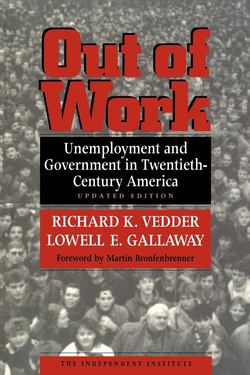Читать книгу Out of Work - Richard K Vedder - Страница 15
На сайте Литреса книга снята с продажи.
RACIAL DIFFERENCES
ОглавлениеThe answer to that question, as table 1.3 suggests, is “no.” Turning first to racial distinctions, note that the white-nonwhite unemployment rate differential widened dramatically in percentage terms as the twentieth century proceeded. The 1900 data are not comparable with other years, since they reflect unemployment flows over a twelve-month period, rather than the stock of unemployed as of a specific date. Data on the average duration of unemployment by race suggest that blacks and other nonwhites tended to be unemployed for shorter periods than whites in 1900. Some 55.4 percent of nonwhites were unemployed for three months or less, compared with 47.7 percent of whites.8 The proportion of whites unemployed for seven or more months was nearly twice as high as for nonwhites.9
The effect of the differential duration is to bias the the reported race differential in the direction of overstating it. To illustrate, suppose that over a given year there were ten black workers, four of whom were each unemployed for three months, with each of their unemployment not overlapping with the others. Further assume there were ten whites, one of whom was unemployed for the entire year. The incidence of unemployment, twelve worker months, is the same for both groups. Yet the reported unemployment rate using the 1900 census procedure would have been 40 percent for nonwhites (four were unemployed out of ten), and 10 percent for whites. Using current measurement procedures, the reported rate for both racial groups would have been 10 percent.
Making a number of assumptions, it is possible to estimate a point-in-time unemployment rate for 1900 which is highly consistent with the official (Lebergott) annual data.10 Doing so, we obtain a white unemployment rate of 6.47 percent and a nonwhite rate of 7.57 percent. The racial differential is about 17 percent, with the absolute differential being slightly more than one percentage point. The 1930 data suggest actually a slightly lower unemployment rate among nonwhites—5.17 percent—than among whites—6.19 percent. Assuming the 1900 and 1930 observations are reasonably representative of intervening years, it would seem reasonable to conclude that the white/nonwhite unemployment differential was of a negligible magnitude in the period from 1900 to 1930.
TABLE 1.3 AGE, RACE AND GENDER DIFFERENTIALS IN UNEMPLOYMENT RATES, 1900–88
Further examination of the data suggests the large racial differential in unemployment rates had its genesis in the 1930s and 1940s, with an additional aggravation of that difference in the 1970s. While Americans often pride themselves on reducing racial economic distinctions over time, the evidence on unemployment is highly inconsistent with that sanguine interpretation. Other data on employment confirm the deterioration in black job opportunities.11 It would appear that over time, racial variations in the natural rate of unemployment have grown very substantially.
